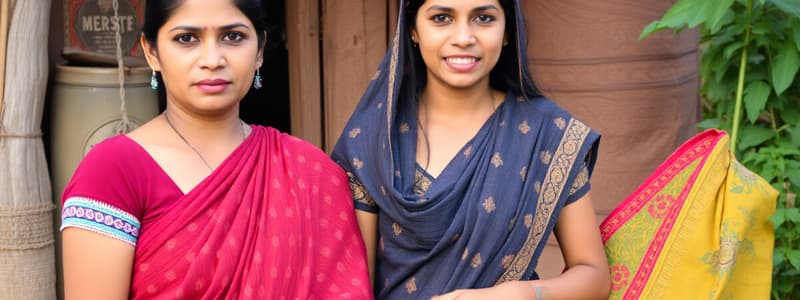Podcast
Questions and Answers
What does GAD stand for?
What does GAD stand for?
Gender and Development
What are the six levels of gender awareness?
What are the six levels of gender awareness?
Gender Blind, Gender Aware, Gender Sensitive, Gender Responsive, Gender Fair/Equity, Gender Accountable
Gender is defined as the biological characteristics of being male or female.
Gender is defined as the biological characteristics of being male or female.
False (B)
What is the purpose of the "Parable of the Blind Men and the Elephant"?
What is the purpose of the "Parable of the Blind Men and the Elephant"?
What are the four phases of the sexual response cycle?
What are the four phases of the sexual response cycle?
What are the three categories of gender roles?
What are the three categories of gender roles?
What are the key agents of gender socialization?
What are the key agents of gender socialization?
Gender roles are fixed and unchanging.
Gender roles are fixed and unchanging.
Flashcards
Sex
Sex
The biological characteristics that distinguish males from females, such as chromosomes, hormones, and reproductive organs.
Gender
Gender
Socially constructed expectations, roles, and behaviors associated with being male or female.
Gender Socialization
Gender Socialization
The process by which individuals learn and internalize the norms, behaviors, and attitudes associated with their assigned sex.
Agents of Gender Socialization
Agents of Gender Socialization
Signup and view all the flashcards
Gender and Development (GAD)
Gender and Development (GAD)
Signup and view all the flashcards
Gender Equality
Gender Equality
Signup and view all the flashcards
Gender Equity
Gender Equity
Signup and view all the flashcards
Gender Awareness
Gender Awareness
Signup and view all the flashcards
Gender Sensitivity
Gender Sensitivity
Signup and view all the flashcards
Gender Responsive
Gender Responsive
Signup and view all the flashcards
Gender Blind
Gender Blind
Signup and view all the flashcards
Gender Roles
Gender Roles
Signup and view all the flashcards
Gender Division of Labor
Gender Division of Labor
Signup and view all the flashcards
Gender Gap
Gender Gap
Signup and view all the flashcards
Gender Socialization
Gender Socialization
Signup and view all the flashcards
Sexuality
Sexuality
Signup and view all the flashcards
Sex
Sex
Signup and view all the flashcards
Sex Roles
Sex Roles
Signup and view all the flashcards
Primary Sex Characteristics
Primary Sex Characteristics
Signup and view all the flashcards
Secondary Sex Characteristics
Secondary Sex Characteristics
Signup and view all the flashcards
Canalization
Canalization
Signup and view all the flashcards
Manipulation
Manipulation
Signup and view all the flashcards
Verbal Appellation
Verbal Appellation
Signup and view all the flashcards
Gender Equality
Gender Equality
Signup and view all the flashcards
Women's Empowerment
Women's Empowerment
Signup and view all the flashcards
Parable of the Blind Men and the Elephant
Parable of the Blind Men and the Elephant
Signup and view all the flashcards
Family-Centered Development
Family-Centered Development
Signup and view all the flashcards
Study Notes
Gender and Society Overview
- The course examines gender and society, specifically focusing on Gender and Development (GAD)
- The course covers understanding sex, sexuality, and gender
- The course will cover the meaning of sex and sexuality, sex roles and morality, the meaning of gender, and theoretical perspectives of gender
- GAD is an approach to development that considers women's needs and perspectives.
- GAD was adopted by national governments in the 1980s.
- GAD promotes participatory processes, empowerment, and sustainable development.
- Communities and institutions should be free from violence, respect human rights, and support self-determination and human potential
Defining Development
- Economic development focuses on factors such as market growth, modernization, infrastructure improvement, and trade/employment.
- There's also a "People-Centered" approach to development.
Gender and Development (GAD)
- GAD aims to achieve gender equality, reflected in development choices.
- It emphasizes women's role as active agents of development, rather than passive recipients.
- Gender equality necessitates equitable sharing of responsibilities, power, authority, and benefits between women and men.
Gender Milestones
- Gender Blind: Lack of recognition that gender is a determinant of life choices in society.
- Gender Aware: Acknowledgment of gender inequality and the differences in access to resources and opportunities between men and women.
- Gender Sensitive: Understanding the underlying causes of gender inequality and its effects. Recognizing identifiable problems resulting from this.
- Gender Responsive: Implementing programs, projects, and processes that systematically address gender concerns and issues.
- Gender Fair/Equity: A society where both men and women are equitably responsible for roles, power, authority, and benefit.
- Gender Accountable: An organization that takes responsibility to make gender an integral part of its operations.
Concepts of Gender
- Gender is socially constructed and based on categories and roles of femininity and masculinity, and is influenced by time and place.
- Gender is a set of qualities, roles, responsibilities, attitudes, and values assigned by culture and society to those identified as women and men.
- Gender is not static; it is subject to change.
Gender Sensitivity
- Sensitivity involves acknowledging and understanding the varied perspectives of men and women based on their experiences, interests, and social locations.
Core Messages on Gender Sensitivity
- The core messages relate sex and gender to aspects of family, school, church, media, and widen/wad.
- Messages connect these factors to gender inequality and equality.
Sex and Sexuality
- Sex refers to biological characteristics (e.g., chromosomes, reproductive organs).
- Human Sexuality encompasses knowledge, beliefs, attitudes, values, and behaviours of individuals.
Primary and Secondary Sex Characteristics
- Primary sex characteristics differentiate biological males and females.
- Secondary sex characteristics are physical changes associated with puberty.
Sex Roles
- They are typically socially coded behaviours and practices related to reproductive capacities, involving traditional roles like motherhood for women and fatherhood for men.
- There are differences between female and male roles regarding reproduction (gestation, lactation, childbearing vs. fertilization, sperm production).
Human Sexuality
- Understanding human sexuality involves investigating anatomy, physiology, biochemistry, individual roles, thoughts, feelings, behaviours, and relationships during different stages.
Sexual Response Cycle
- A cyclical sequence with stages of excitement, plateau, orgasm, and resolution.
Christianity's View of Sex
- Christianity views sex as a gift to be celebrated and practiced as God intended (for pleasure, procreation, and intended purposes).
Gender Division of Labor
- Typically men occupy the productive role (generating income) and women fill the reproductive roles (childcare, household duties, family care).
- Both contribute to community activities and projects.
Gender Gap
- A condition where men and women in a culture or society have unequal access to and unequal valuation of resources.
Gender Socialization
- The process that shapes an individual's values, attitudes, behaviour and beliefs about gender, often during childhood.
- Key agents include family, school, media, church, and the workplace.
Agents of Gender Socialization
- Family: Plays a crucial role in shaping children's values and beliefs about gender roles through verbal appellations, and actions, and can involve manipulation of behaviors based on gender.
- School: Gendered lessons, unequal treatment of male and female students, and gender bias in textbooks, computer softwares, and teaching styles.
- Media: Reinforces gender stereotypes and discrimination, based on the portrayal of men and women.
- Church: Religious texts and doctrines often uphold gender roles, leading to a view of women and men as unequal.
- Workplace: Often presents unequal pay structures and relations, and can involve gender-related discrimination or harassment.
Studying That Suits You
Use AI to generate personalized quizzes and flashcards to suit your learning preferences.




